Go-To-Market Strategy: 8 Mistakes to Avoid for Successful Growth Strategies for Companies
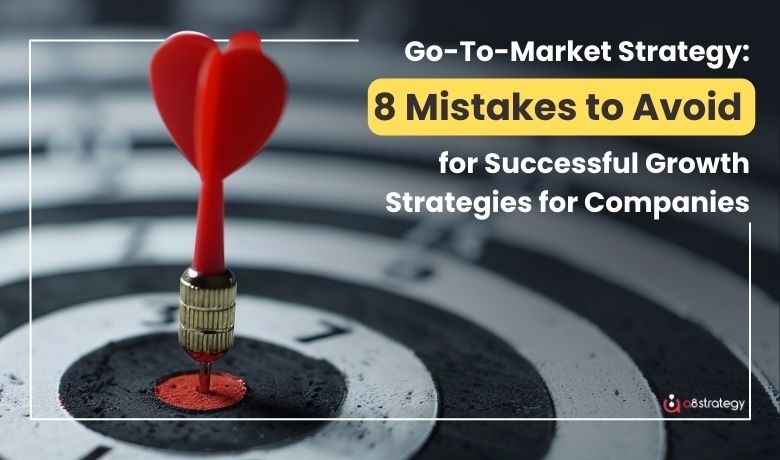

90% of startups fail. This is the reality of today's marketplace, a statistic frequently highlighted by sources like Forbes: most new businesses fail to succeed. Even within established corporations, the majority of product launches fail to meet their stated targets. Many people fail in the market, but this is not usually because they lack effort or ambition. Instead, it often happens because they have a poor strategy for entering the market.
A go-to-market strategy is a key plan that outlines how a company will connect with customers and establish a lasting competitive edge. It's a detailed action plan that goes beyond a simple launch checklist, explaining how an organization will offer its unique value to a specific audience. This makes it one of the most vital growth strategies for companies seeking to introduce a new product or enter a new market.
It is essential to distinguish this from a general marketing plan. While a marketing plan focuses on ongoing brand communications, a go-to-market strategy is specifically concentrated on the critical, high-stakes moment of a single product's launch or a company's expansion.
Many businesses fail not because their product is bad, but because their market entry plan is built on a foundation of strategic oversights. This guide explains the eight common mistakes that can harm a go-to-market strategy. It will give you a clear framework to help you avoid these pitfalls and find a path to sustainable growth.
Mistake #1: Inadequate Market Research & Audience Definition
The biggest mistake in strategic planning is launching a product based on internal excitement and assumptions, rather than solid evidence from outside sources. This oversight often leads to creating products that people do not want, marketing to the wrong audience, or aiming for a market that doesn’t exist.
The pressure to launch is very high; research from the Product Marketing Alliance shows that 49% of go-to-market teams struggle to collect consumer research fast enough, leading them to "jump the gun" and proceed with unverified assumptions.
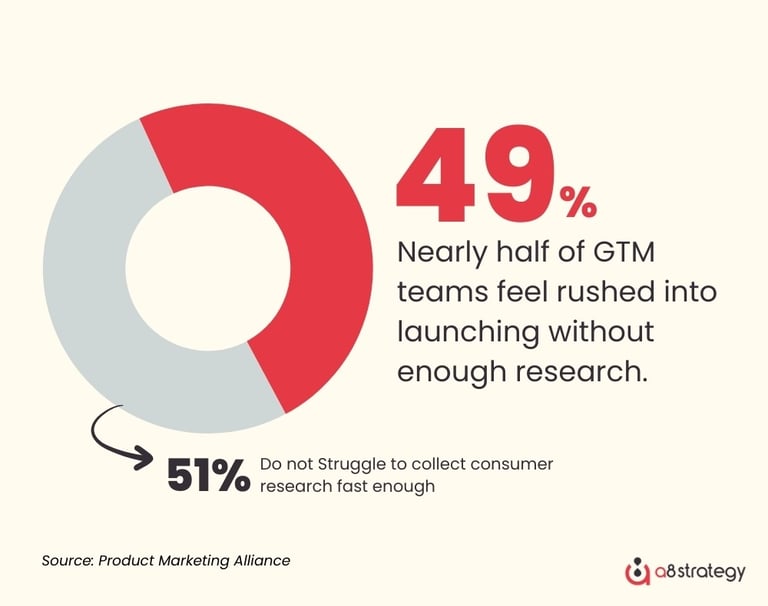

This failure to validate ideas externally creates a domino effect. When internal excitement for an idea isn't checked against reality, it fuels confirmation bias, where teams only seek out data that supports their pre-existing beliefs.
This leads to rushed or incomplete research, resulting in a product that is fundamentally misaligned with the actual needs of its target audience. This situation shows a misunderstanding of marketing's main purpose. As marketing expert Philip Kotler points out, marketing is the "homework" a company does to identify needs and develop solutions before creating a product.
How to Avoid This Mistake:
Develop a Detailed Ideal Customer Profile (ICP):
An effective Ideal Customer Profile (ICP) goes beyond basic demographics. It should include the specific characteristics of the target companies, such as their industry, size, and revenue. It also needs to address the common challenges these companies face and identify the main decision-makers within them.Build Actionable Buyer Personas:
Personas make data from the Ideal Customer Profile (ICP) easier to understand. They are detailed profiles that describe an audience's specific challenges, professional values, daily priorities, and the online channels they use.Conduct Rigorous Market Validation:
You should test your ideas about market demand rather than assuming they are correct. You can do this by using customer surveys, focus groups, and creating a Minimum Viable Product (MVP).Perform Deep Competitive Analysis:
To identify gaps and opportunities, you must carefully analyze your competitors. Look at their products, pricing, market position, and how they communicate.
Mistake #2: A Vague Value Proposition & Weak Positioning
The Problem: Failing to Answer "Why Should I Care?"
Even with a great product, a launch will fail if potential customers don’t quickly see why it matters to them. The problem is a weak or unclear value proposition, which fails to solve the customer's need for clarity and differentiation in a crowded market. Warning signs include high bounce rates, low trial conversions, and customers who only compete on price because they see no other value.
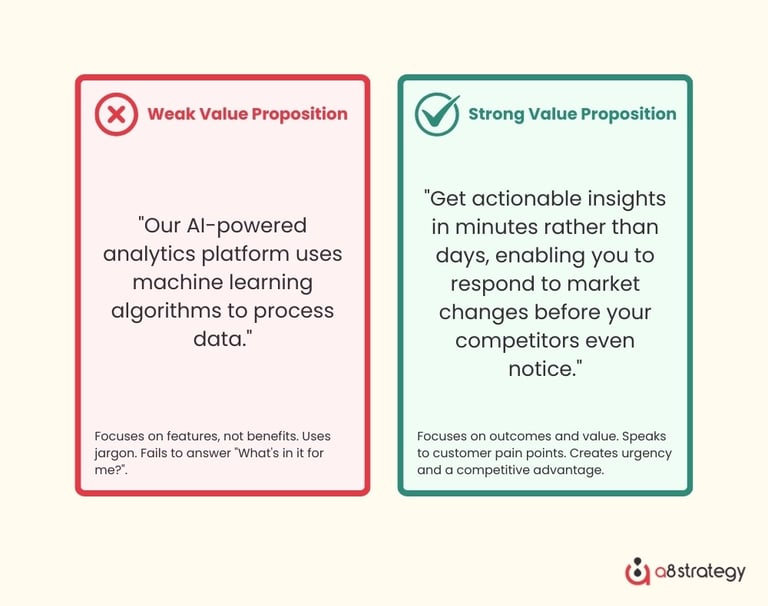

The Solution: Engineer a Clear, Benefit-Driven Message
This failure occurs when a company lacks empathy for its customers' problems and focuses internally on its own features. The solution is to systematically build a message that resonates with the customer's needs.
Start with the Customer's Pain Points:
Frame the value proposition from the customer's perspective, articulating the specific problem the product solves.Identify and Amplify Your Unique Differentiators:
Know what your product can do that no other can. Use win/loss analysis to uncover decisive features.Craft a Simple, Memorable Message:
Strip the value proposition of jargon. It should be easy to understand, remember, and repeat. Test it rigorously.
Mistake #3: Misaligned Sales, Marketing, and Business Strategy
A go-to-market strategy is often created in just one department, which is a big mistake. When sales and marketing teams work separately, it leads to problems like mixed messages, wasted resources, and confused customers. It is even more harmful if the go-to-market plan does not connect well with the overall business strategy.
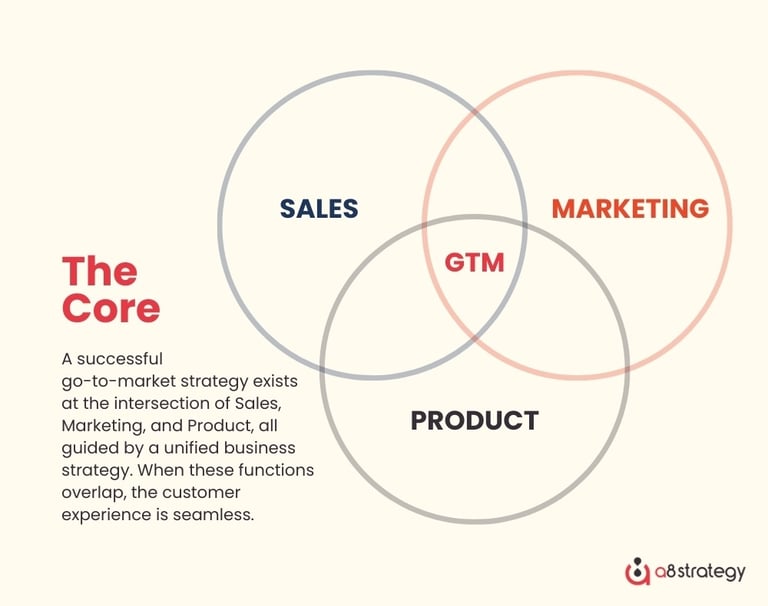

An effective go-to-market strategy requires teamwork across different departments. A key McKinsey survey found that team collaboration is the single most important factor for success.
When teams are not aligned, the results can be serious. Conflicts often arise between different teams because they measure success in various ways (for example, focusing on marketing qualified leads instead of closed sales). This creates blame and inefficiency. A good go-to-market strategy can drive change within a company, helping it to work together as one customer-focused team.
How to Avoid This Mistake:
Establish a Single Source of Truth and Shared Goals:
All teams must use the same playbook, have shared revenue-focused goals, and work with a standard customer relationship management system.Appoint a Dedicated GTM Leader:
Choose one person to lead the entire go-to-market (GTM) process and make sure all teams work together effectively.Align GTM with Business Strategy:
The GTM plan should directly support the company's long-term strategy, revenue targets, and market position.
Mistake #4: An Inflexible or Poorly Researched Pricing Strategy
Pricing plays a crucial role in a go-to-market strategy, but it's often handled poorly. One major mistake is setting prices based on costs within the company instead of on market conditions and what customers value. If prices are too high, people won’t buy the product. If prices are too low, the company loses potential revenue and may seem cheap.
Pricing is a key part of how a company positions itself in the market. When done well, it can drive significant growth. As pricing experts at Price Intelligently note, pricing is the exchange rate on the value you provide. A poor pricing strategy usually shows a lack of belief in the product's value, which can lead to prices being lowered too much.
How to Avoid This Mistake:
Conduct Price Sensitivity Research:
Use techniques like conjoint analysis or surveys to understand what customer segments are willing to pay.Adopt a Value-Based Approach:
Set prices based on the perceived value and ROI the product delivers to the customer, not on your internal costs.Consider Flexible and Tiered Models:
Explore segmented pricing, "good/better/best" tiers, or usage-based billing to capture value from a wider range of customers.Benchmark, But Don't Blindly Copy:
Analyze competitor pricing to understand the landscape, but anchor your price in the unique value you provide.
Mistake #5: Premature Scaling and Flawed Launch Execution
A key mistake is trying to grow a go-to-market strategy before proving it works. Focusing on improving an untested process can result in wasted time, money, and energy.
It's essential to recognize that "founder-led sales" are vital in the early stages. The sales process is about learning as much as it is about making money. Hiring costly sales leaders or depending on partners too soon can hinder this vital learning phase.
How to Avoid This Mistake:
First, Find a Repeatable Model:
Before scaling, establish a sales process that works consistently for your ideal customer profile.Develop a Meticulous Launch Plan:
Use a comprehensive launch readiness checklist and a clear RACI matrix to ensure coordination and eliminate ambiguity.De-Risk with a Phased Rollout:
Conduct a soft launch to a limited audience to test execution, gather feedback, and make adjustments before a full release.Use Channel Partners Strategically, Not Prematurely:
Partnerships are a force multiplier after a direct sales motion has been perfected.
Mistake #6: Ignoring the Metrics That Matter
A business cannot effectively manage what it does not measure correctly. One common mistake is tracking "vanity metrics" like website traffic or social media likes. These numbers may feel good, but they do not lead to increased revenue. When entering a market, it is crucial to focus on key performance indicators (KPIs) that truly reflect business success.
Incomplete data poses a significant risk. For instance, calculating an actual Customer Acquisition Cost (CAC) means including all sales and marketing expenses, not just advertising costs. This should also cover salaries and tools. Not doing this may create an overly optimistic view of profitability.
Fully-Burdened CAC (Customer Acquisition Cost)
Definition: Total sales and marketing costs, including salaries, benefits, tools, and advertising, divided by the number of new customers gained in a specific time frame.
Why It's Important: This shows the complete cost of acquiring one customer. It helps avoid overly optimistic financial predictions and ensures that the business model is truly profitable.LTV to CAC Ratio
Definition: The ratio of a customer's lifetime value (the total revenue a customer is projected to generate) to their acquisition cost.
Why It's Important: This is the ultimate measure of GTM profitability and sustainability. A healthy ratio, often cited as being 3:1 or higher, indicates a scalable and healthy business model.Sales Cycle Length
Definition: The average amount of time from the first contact with a prospect to the closing of a deal, often segmented by customer type or deal size.
Why It's Important: This metric is essential for accurate revenue forecasting. It also helps identify bottlenecks in the customer journey where prospects are getting stuck or dropping out.Segment Profitability
Definition: A detailed analysis of revenue and costs broken down by specific customer segments (e.g., SMB vs. Enterprise, or by different industries or use cases).
Why It's Important: This analysis ensures that overall growth is not masking unprofitability in specific segments. It allows a company to focus its resources on its most profitable customers strategically.Lead-to-Conversion Rate
Definition: The percentage of leads that complete a desired action, such as submitting a contact form, starting a free trial, or completing a purchase.
Why It's Important: This is a direct measure of the effectiveness of the messaging and the quality of the leads being generated. Consistently low rates signal a problem with the value proposition or audience targeting.
Mistake #7: Overlooking the Post-Launch Customer Journey
A costly mistake is the "fire and forget" mentality. Many companies pour all their energy into the launch event, then immediately pivot. The go-to-market strategy does not end at the first purchase. Sustainable growth comes from turning that transaction into a long-term relationship through excellent onboarding, proactive support, and deliberate retention efforts.
Failing to invest in this post-launch experience is a direct path to high customer churn, which cripples Customer Lifetime Value (LTV). This shortsightedness often results from an organization being structured around product launches rather than customer lifecycles.
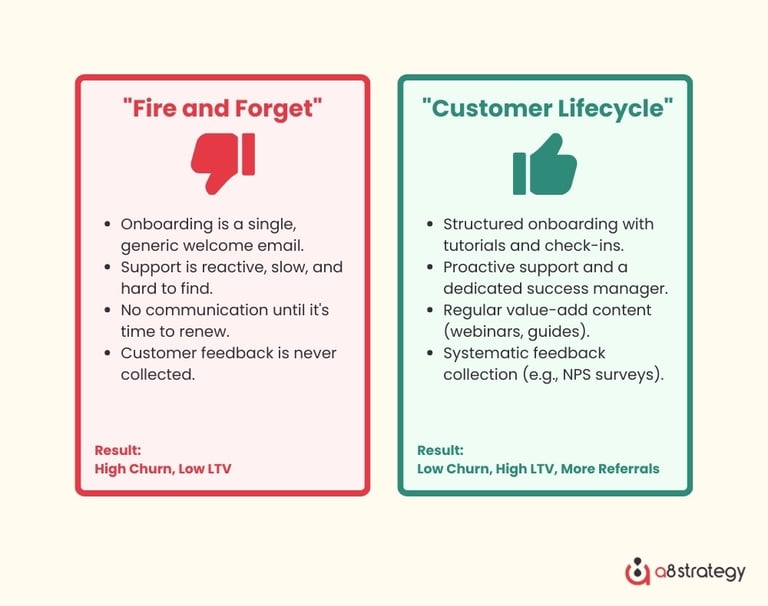

"The aim of marketing is to know and understand the customer so well the product or service fits him and sells itself." – Peter Drucker
How to Avoid This Mistake:
Map the Entire Customer Journey:
Create a clear map of the post-purchase experience, covering onboarding and support, to minimize potential issues.Invest in Customer Success and Sales Enablement:
Train and equip customer-facing teams to help customers get the value they expect.Establish a Continuous Feedback Loop:
Set up formal ways, like surveys and interviews, to gather feedback from our first group of customers. Use this information to help improve our product and marketing efforts.Plan for Retention Marketing:
Use tactics like newsletters, webinars, and loyalty programs to connect with existing customers and encourage them to promote your brand.
Mistake #8: A Generic, "Me Too" Go-To-Market Strategy
Many companies make a big mistake by copying their successful competitors. This strategy leads to average results instead of market leadership.
An effective go-to-market strategy should not be a one-size-fits-all approach. It needs to reflect the unique strengths of the company and have a clear, distinct perspective. Differentiation is essential for successful growth strategies for companies.
The "me too" approach often comes from a lack of confidence in strategy. Companies that invest time in research, value propositions, and team alignment will feel more confident and have the resources to develop a unique approach. If a company skips these steps, it may resort to copying others.
"We need to stop interrupting what people are interested in & be what people are interested in." – Craig Davis.
A sharp, focused go-to-market strategy is always more powerful than a broad, generic one. The market is not static; your strategy must be a dynamic, adaptable plan that is constantly measured, tested, and refined.
Pave Your Path to Market Success
To build a strong and successful market entry, avoid these eight major mistakes. The key is matching your insights and analysis to your audience's real-world needs. As the saying goes, "One glove doesn't fit all; understand your audience behavior." There is no "one-size-fits-all" go-to-market strategy.
While some frameworks exist, each company is unique. A solid go-to-market strategy is essential. It is the key investment that sets high-growth companies apart from the 90% that fail. By conducting thorough research, ensuring internal teamwork, and focusing on customer value, you can confidently navigate today’s complex market.


